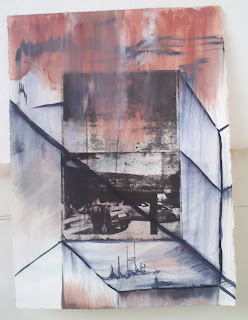The process is quite simple but its a delicate operation. A black and white print from a laser copier is made wet and covered in gum arabic and then lithography ink. The gum arabic ensures that the ink sticks only to the carbon on the paper so you get a reproduction of the image on your selected surface. You run it through the press over paper or what not and you have a grainy copy of the picture.
 |
| One of my small lithography prints |
 |
| The same print which I painted over |
After I painted over this first print that I made I started making a lot more of them. Inevitably I decided I needed to expand the scale and to try and print on a large canvas(approx 2x3m).
Then came the problems. First was the canvas surface, testing the printing onto different pieces of canvas I realised how smooth the surface needed to be for the print to work. Next was A3 being the largest laser copy I could make so I had to split my image into nine pieces which I would reconstruct during the printing.
 |
| splitting the image in Photoshop |
Then there was the fact that the canvas was too large to fit through any of the presses and so I had to burnish the whole thing by hand. Not a problem, who doesn't like struggling for their art?
And struggle I did. The whole process is a struggle to recreate a picture you can already see perfectly. For me this really made me think again about memory and recollection, most of the time you try really hard to preserve or recreate something that's never going to be what it was. When I was inking up the soaking wet paper you can see your picture perfectly but its so fragile and I knew from the beginning the recreation of the image would never be what it once was.
 | ||
| Final printed image ready for painting |
Another thing I discovered while making the print is that I'm not a printmaker, which is quite ironic. I made a LOT of mistakes and being a painter my attitude was 'I can fix it later' which I did, painters can fix ANYTHING later. Printmakers though, well most, are so conscientious and used to making perfect multiples that if the tiniest little blotch occurs they shove it in the recycling.
No comments:
Post a Comment